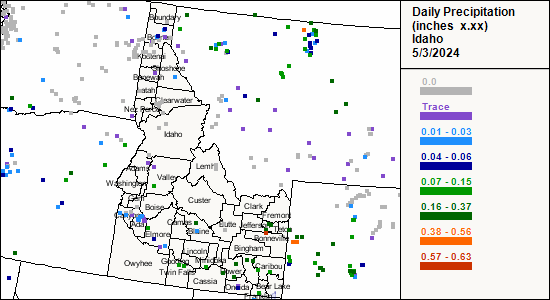|
|

Welcome to CoCoRaHS Idaho! First Year Completed and Going Strong!
CoCoRaHS Idaho officially launched in the Gem State on January 1, 2009. By the end of the first year, we have grown to 125 observers. We continue to welcome new volunteers to sign up and begin measuring and submitting records. Sign up is available now, and you can begin submitting your measurements as soon as you have a login. Even if you don't have an official gage yet, you can begin by entering snow depth on the ground, and new snowfall. All that requires is a ruler! Help us measure precipitation from the Kaniksu National Forest to Bear Lake as we learn about this wonderful resource that falls from the sky. To join CoCoRaHS in Idaho click here: Join CoCoRaHS
Allow me to introduce myself. I am Russ Qualls, the statewide Idaho CoCoRaHS coordinator. I live in Moscow, am both a faculty member in the Department of Biological and Agricultural Engineering at the University of Idaho, and the Idaho State Climatologist, which you can find out more about here (http://snow.ag.uidaho.edu/index.html). I am also a CoCoRaHS observer.
Winter Measurement Tip: For those of you who have gauges already, you may find that during snowfall, that the gauge captures far less snow than accumulates on the ground. For this reason, we recommend that you find a spot where the snow depth is about average, and take a "core sample" by pressing your inverted gauge down into the snow to the ground (for cumulative snow depth), or to the "snow board" (for new snowfall), slide a flat object, such as a fly swatter, spatula, or dry-wall taping knife, under the inverted mouth of the gauge to hold the snow inside the gauge while you turn it right side up, and melt and measure that snow to record as your official precipitation measurement. More details on this procedure appear in the "training slide-show" which can be accessed under the "Resources" menu at left. There is also now a new training slide-show on weighing your precipitation gage, which eliminates the need to melt the snow, which those of you who have done this will recognize as a big time-saver. All you need is a scale that can weigh down to the resolution of 1 gram or better (or 0.03 ounces, or 0.002 pounds).
Thanks for joining as an observer, or just coming to look at our data. If you have any questions, please feel free to contact me or any of the four Idaho regional coordinators. Our contact information can be found on the State Menu/State Coordinators link at the top left.
Russ Qualls
|
|